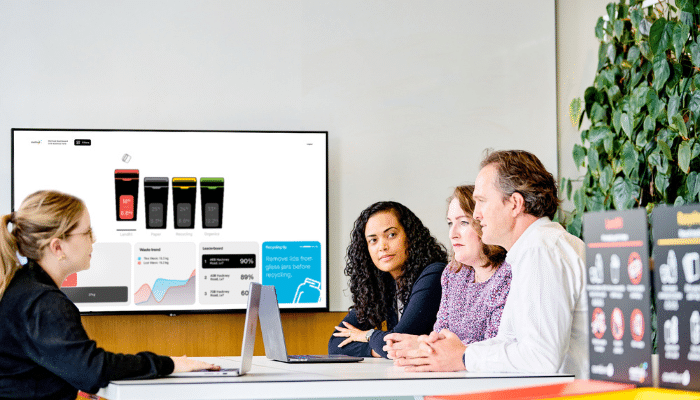What is IoT?
The Internet of Things. From turning on your lights at home with your voice, to the hospital tracking your heartbeat in real-time, to working in an office that can automatically predict what heating, ventilation and air conditioning is needed based on how many people are in a conference room, the Internet of Things (IoT) is everywhere in our lives.
IoT is physical objects that are embedded with sensors and sometimes actuators. IoT technologies connect physical objects to wired or wireless networks to monitor or control an environment.
IoT helps us be connected to the things we care about, like measuring our sleep or exercise with accurate and timely data that enables us to understand and improve.
IoT for office waste
Method, makers of the beautiful bins, have designed Method InSight – an IoT solution for waste that gives organisations the ability to understand their waste better than ever before.
- Weight sensors under every bin for granular insights
- Data is updated every hour for real-time access
- Automatic weight collection – no manual handling
- Analyse & report across all of your business locations
- Identify underperforming areas and gamify waste
Not only does InSight enable efficient waste monitoring, but reliable data is also presented in a user-friendly way with dynamic displays, graphs, and filters, making it easy to dive deep into bin-by-bin data or zoom out to view waste across different teams, stations, buildings or even countries. InSight’s smart waste management system enables waste metrics to be displayed digitally near bin stations, or online, helping to inform and engage employees with waste diversion goals and progress.
IoT for the Microsoft’s Zero Waste Goal
Microsoft made a global commitment to becoming zero waste by 2030, and many of their US campuses have already achieved this mammoth goal. The Australia and New Zealand offices knew they needed to get onboard, but they didn’t have any way of accurately tracking their rubbish, let alone in real time.
In 2021 and 2022, Method InSight was deployed at four Microsoft offices across Australia and New Zealand – Brisbane, Perth, Auckland and Wellington.
With the bins in place, Microsoft’s teams in each office immediately started seeing patterns appear. As you might expect, lunchtime was rush hour at the bins, generating the highest rates of waste of all kinds, but especially the non-recyclable kind destined for landfill.
Individual offices showed unique patterns. For example, Perth saw a spike in organic waste first thing on a Monday. Method’s customer experience team worked with Perth to determine that this particular spike was due to tossing fruit from the week before.
All this data allowed the creation of waste-busting solutions. To combat the Monday morning fruit dumping, it was suggested adjusting Microsoft’s fruit order so less got wasted each week, or encouraging workers that came into the office on Thursdays or Fridays to take the fruit home, so it still got eaten. Weeks later, Microsoft and Method have seen a 40% reduction in these organic waste spikes and are continuing work to reduce this further.
InSight has already created serious inroads into Microsoft’s waste. With its help, Microsoft ANZ has moved waste diversion up to 82-84% across sites.
“We know we still have a long way to go to reach our zero waste target, but this has given us the tools to get there. We now have the means to educate all our people on how, individually, they can make a difference to our organisation and our planet, and that’s been hugely motivating. It’s not just about the ‘big stuff’ like datacenter cooling technology, we all have the power to make a change,” says Roseann O’Hare, Microsoft ANZ Sustainability Lead.
Want to learn more? Visit Method at AWRE on stand B20 for a demo or visit their website here.



